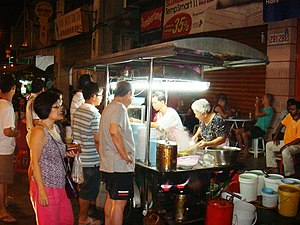 A Chinese wantan mee hawker stall in George Town. | |
| Total population | |
| 718,362 41.3% of Penang's population in 2020[1] (census) | |
| Regions with significant populations | |
| Languages | |
| Penang Hokkien and Malaysian Mandarin (lingua franca) Malaysian, Kedah Malay, English, Manglish Other dialects: Cantonese, Teochew, Hakka | |
| Religion | |
| Predominantly Buddhism and/or Taoism, with a significant number of Christians. Minority: Islam, Atheism | |
| Related ethnic groups | |
| Chinese diaspora, Peranakan, Chindian |
Penangite Chinese are ethnic Chinese Malaysians of full or partial Chinese ancestry who either hail from or live within the State of Penang. As of 2020[update], 45% of Penang's population belonged to the Chinese ethnic group, making ethnic Chinese the largest ethnic community within the state.[3][4]
Most Chinese Penangites are the descendants of Chinese colonists, traders, accountants, merchants, labourers and immigrants from southern China who moved to the Penang between the 18th and 20th centuries. By the mid-19th century, George Town, the capital city of Penang, was home to a significant Peranakan community, also known as the King's Chinese due to their loyalty to the British crown.[5] Under British colonial rule, Penang continued to experience increasing Chinese immigration throughout the 19th century. As the largest group of Penangite Chinese are ethnic Hokkiens (38% of the Chinese penangite population in 1957)[6][7] who came from southern Fujian Province, home to the Hokkien language, Penang Hokkien was gradually developed and is now widely used by Penangites for daily communication.
Penang's Chinese have been well-represented within Malaysia and also internationally in various professional, political, economic and other fields. To date, Penang is the only state in Malaysia where the position of the Chief Minister, who leads the state government, has been continuously held by an ethnic Chinese since independence. Renowned figures, including Jimmy Choo and Nicol David, hailed from Penang and have contributed greatly in raising the country's profile internationally.
Penangite Chinese typically refer to themselves as Tn̂g-lâng in Penang Hokkien.[8] In English parlance within Penang, Penangite Chinese are simply referred to as "Chinese".
- ^ "Key Findings of Population and Housing Census of Malaysia 2020" (pdf) (in Malay and English). Department of Statistics, Malaysia. ISBN 978-967-2000-85-3.
- ^ a b "MyCensus 2020: Mukim/Town/Pekan". Department of Statistics Malaysia. Putrajaya: 174–175. February 2024. ISBN 9789672537069.
- ^ "Current Population Estimates 2017". Malaysian Department of Statistics: 55. 14 July 2017.
- ^ "Penang – not so Chinese after all". Free Malaysia Today. 2011-06-10. Archived from the original on 2016-03-13. Retrieved 2016-12-31.
- ^ Singapore, National Library Board. "Peranakan (Straits Chinese) community | Infopedia". eresources.nlb.gov.sg. Retrieved 2016-12-31.
- ^ Koh Aun Qi (9 September 2017). "Penang Hokkien and its struggle for survival".
- ^ "The process and effects of demographic transition in Penang, Malaysia". January 2013.
- ^ Johny Chee (2008). A Tapestry of Baba Poetry. Areca Books. ISBN 9789834291211.
© MMXXIII Rich X Search. We shall prevail. All rights reserved. Rich X Search
